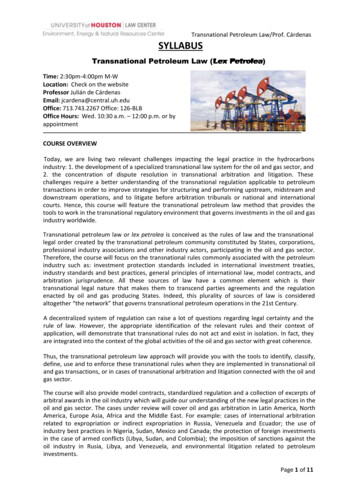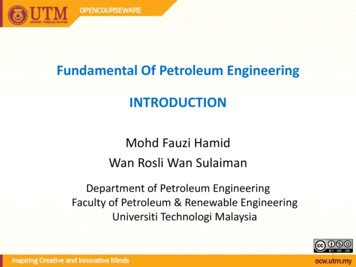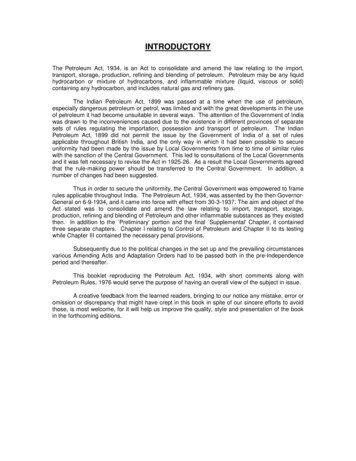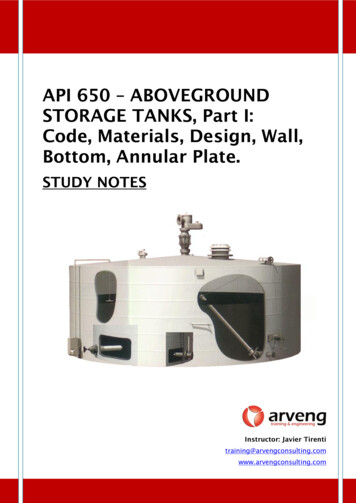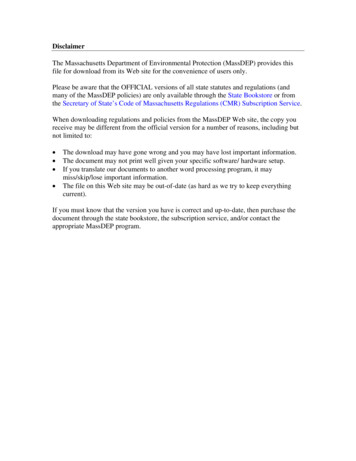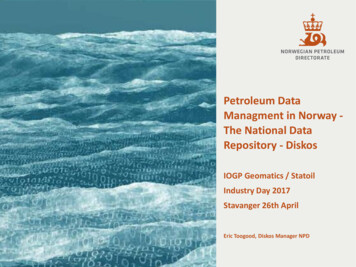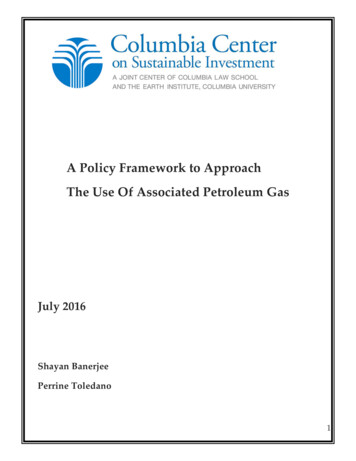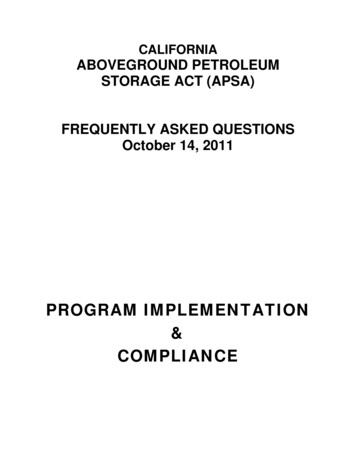
Transcription
CALIFORNIAABOVEGROUND PETROLEUMSTORAGE ACT (APSA)FREQUENTLY ASKED QUESTIONSOctober 14, 2011PROGRAM IMPLEMENTATION&COMPLIANCE
Table of ContentsI. General Administration . Page 91. What is the relationship between APSA and the Federal Oil Spill Prevention Program?2. Who is responsible for the implementation and administration of the APSA Program?3. What are the release reporting requirements for petroleum spills/releases at an APSAregulated tank facility?4. Who is responsible for cleanup and abatement of releases from ASTs under APSA?II. Applicability . Page 111. Who is subject to the requirements of APSA?2. What is a tank facility?3. What is petroleum?4. Is biodiesel regulated under APSA?5. Is propane, liquefied petroleum gas, or liquefied natural gas regulated under APSA?6. What tank facilities are conditionally exempt from the APSA requirement to prepare andimplement an SPCC Plan?7. Does the federal SPCC exemption for wastewater treatment systems/facilities apply totank facilities regulated under APSA?8. What tanks are excluded from the definition of “aboveground storage tank?”9. Does any percentage of petroleum oil content in a mixture (no matter how small) bringthe mixture into APSA regulation as 'petroleum?'10. Are hazardous waste tanks regulated under APSA?11. Are businesses with aboveground storage tanks containing vegetable and/or animal oil,which are regulated under the federal SPCC plan rule, also included under the APSAprogram?12. Are aboveground petroleum storage tanks located on oil production facilities exemptfrom APSA?Revision Date 10/14/2011Page 2
13. Does the phrase “construction site” as used in section 25270.4.5 (b) of the Health andSafety code include quarries and construction “yards?”14. Construction activities are being performed on a portion of a manufacturing, commercialor maintenance facility with aboveground tanks. Is the entire facility considered a“construction site?”15. Are federal facilities regulated under APSA?16. Could circumstances exist that would cause an UST to be regulated under APSA?17. What is the definition of a farm?18. Does the term “farm,” as used in Health and Safety Code section 25270.4.5 (b) includedairies?19. Is farming equipment, such as tractors, harvesters and other farming equipment subjectto APSA/SPCC?20. If a tank facility has multiple ASTs that are owned and operated by different persons,and if the total capacity of the tank(s) for each business is less than 1,320 gallons, but thetotal for all tanks at this single location exceeds 1,320 gallons, is each business subject toAPSA?21. If a single location houses multiple ASTs that are owned by different businesses butoperated by the same business, and if the total capacity of the tank(s) owned by eachbusiness is less than 1,320 gallons, but the aggregate total for all tanks operated by thesame operator at this single location exceeds 1,320 gallons, is each business subject toAPSA?22. The revised definition of ‘facility’ in the November 2008 EPA amendments to the federalSPCC rule is far more flexible than the definition of ‘tank facility’ under APSA. Can I followthe federal definition in determining whether I am regulated as a tank facility under APSA?23. When a tank subject to the APSA requirements is owned and operated by two differententities, who do we charge for enforcement purposes, for example when they have notsubmitted a storage statement or completed an SPCC Plan? Do we take enforcementagainst both the owner and the operator?24. Is the term “logging site” defined?25. Would “sawmills” and logging truck operations (yards and shops) fit the meaning oflogging site?26. What types of ASTs are included under the transportation-related tank facility’sexclusion as referenced in HSC section 25270.2(a)(6)?Revision Date 10/14/2011Page 3
27. Are tank facilities regulated under APSA exempt from federal (EPA) regulation underfederal SPCC rules?28. Is there a retail exemption for APSA and/or SPCC?29. Are materials like asphalt, seal coat, tack oil, etc. subject to APSA?30. An APSA-regulated tank facility also conducts loading/unloading of petroleum fromAPSA/SPCC-excluded transportation-related tanker trucks into APSA/SPCC-excludedunderground storage tanks, are the loading/unloading area and operation subject toAPSA/SPCC?III. Aboveground Storage Tanks . Page 271. What is a storage tank?2. What is the minimum tank size considered when calculating a tank facility’s total storagecapacity?3. What is storage capacity?4. How is a tank facility’s storage capacity determined?5. Are petroleum storage tanks in vaults or basements considered to be abovegroundstorage tanks under APSA?6. Is the following description of a tank considered an underground storage tank or is it anaboveground storage tank? The tank’s bottom rests on a single-pour concrete pedestalcovered with a stainless steel sheet in such a manner that the tank bottom cannot bevisually inspected. The tank is located in an open-vaulted area where no portion of the tankis buried but more than 10 percent of the volume of the tank is located below the commonsurrounding soil level.7. Are tanks or containers for hydraulic fluid considered to be ASTs and therefore subject toregulations?8. Are containers with a minimum storage capacity of 55 gallons of petroleum (such as 55gallon drums) regulated under APSA?9. Are oil-filled operational equipment and/or oil-filled manufacturing equipment regulatedunder APSA?10. Does the term “equipment” in HSC section 25270.2(a)(4)(A) and (B) refer to singular orplural tanks?11. If an AST is "empty," is that still an AST?Revision Date 10/14/2011Page 4
12. Are there regulations for underground piping systems associated with ASTs?13. How is underground piping outside the first flange or valve of the containment areaassociated with ASTs regulated?14. Are there requirements for integrity testing of regulated piping? If so, what is the leakdetection threshold?15. Since HSC section 25270.7 of the previous version of APSA has been repealed, arethere still requirements to develop and implement a monitoring plan/program for ASTs?16. Are below grade oil/water clarifiers regulated by APSA?17. Does APSA or SPCC require ASTs to be elevated so that visual inspections of thebottom can be made?18. Would a facility with portable totes that may be moved to different locations throughoutthe facility be required to amend their SPCC plan each time portable tanks/containers aremoved? Do portable tanks require secondary containment?19. Are self-propelled vehicles and equipment which have fuel tanks and hydraulic systemreservoir tanks (such as self-propelled agricultural, construction, and excavation vehiclesand self-propelled cranes) regulated as aboveground tanks under APSA?20. Is the UPA required to review and approve plans for modifications/repair toaboveground storage tanks?IV. SPCC Plans . Page 341. By what date must a tank facility that is subject to the Act have their SPCC Plan preparedand implemented?2. Is it a requirement for tank facilities to submit, file or provide their SPCC Plans to theUPA, or for the UPA to ‘approve’ the Plan?3. Is it a requirement to have a California PE stamp the SPCC?4. Who can sign or certify an SPCC Plan?5. Can a facility use an SPCC Plan template?6. Who reviews the SPCC Plan and how often is the SPCC Plan reviewed?7. When must an SPCC Plan be amended by the facility operator?Revision Date 10/14/2011Page 5
8. Under APSA does a qualified facility have to prepare an SPCC plan certified by aprofessional engineer to address the greater than 42,000-gallons of petroleum stored in theUSTs to meet the federal standards?9. Can a facility prepare an SPCC plan that addresses multiple facilities or would they needto prepare an individual plan for each location?V. APSA Fees . Page 381. Are federal facilities required to pay the APSA fee set forth in section 25270.6 of theHealth and Safety Code?2. Are tank facilities with an aggregate total of petroleum equal to 1,320 gallons but lessthan 10,000 gallon still subject to an UPA’s APSA fees?3. Is there a surcharge on this program for oversight?VI. Tank Facility Inspections . Page 391. How often must the owner or operator perform visual inspections of their ASTs?2. Are owners or operators of unattended tank facilities required to conduct dailyinspections?3. How often can a tank facility expect an UPA compliance inspection?4. What type of activities can a tank facility expect to occur during an UPA complianceinspection?5. How should the UPA inspector identifying various violations of SPCC Planimplementation, plan quality or content, etc., at a tank facility prepare the specific citation?6. Are SPCC-exempt (as defined in APSA) facilities required to be inspected?7. For the purposes of APSA, is an aggregate storage of 10,000 gallons or more the triggerfor triennial UPA APSA inspections?8. What are the “integrity testing” requirements for ASTs? Are these different from therequired frequent inspections?9. How does a tank owner/operator conduct the required frequent inspections of the outsideof the tank/container (reference CFR 112.8(c)(6)) on a double-walled tank?10. Is there a specific type or style of spill kit required for facilities under APSA or SPCC?Revision Date 10/14/2011Page 6
11. Are there specific tank labeling requirements under APSA or SPCC?12. What is the meaning exactly of 24 hours of a 25 year storm event? How does oneobtain this information?VII. Annual Tank Facility Statement . Page 421. Who determines the format and content of the Annual Tank Facility Statement that theowner or operator of a regulated tank facility is required to submit to the UPA?2. Although it states that the business plan can be used in lieu of the annual tank facilitystatement, it would be easier for us to require the regulated businesses to submit an annualstatement instead of a complete business plan (which is not required to be submitted everyyear). Can UPA’s make that determination for their businesses?VIII. Secondary Containment . Page 441. Is a tank facility’s secondary containment required to be constructed of non-permeablematerial?2. Are double-walled containers and other alternative aboveground storage containerssatisfactory to meet the secondary containment requirements for SPCC?3. Must each tank, drum, or other oil storage containers have individual secondarycontainment?4. What are the secondary containment requirements under APSA?5. What is an impracticability determination?IX. APSA Training Program . Page 471. What is the APSA Training Program?2. Is the training ICC certified?3. Is there training available to regulated tank facilities or other interested parties?Revision Date 10/14/2011Page 7
DISCLAIMERThis Frequently Asked Questions (FAQ) document provides guidance to Unified ProgramAgency (UPA) staff and inspectors, as well as to owners and operators of facilities that may besubject to the requirements of the Aboveground Petroleum Storage Act (APSA). The statutoryprovisions described in this document contain legally binding requirements. This document doesnot substitute for those provisions or regulations, nor is it a regulation itself. In the event of aconflict between the discussion in this document and any statute or regulation, this documentwould not be controlling. Thus, it does not impose legally binding requirements on the State,UPAs or the regulated community, and might not apply to a particular situation based uponcertain circumstances. The word “should” as used in this document is intended solely torecommend or suggest, in contrast to “must” or “shall” which are used when restating regulatoryrequirements. While this guidance document indicates the State’s strongly preferred approachto assure effective implementation of legal requirements, the State retains the discretion toadopt approaches on a case-by-case basis that differ from this guidance where appropriate.Any decisions regarding a particular facility will be made based on the statute. This is a livingdocument and may be revised periodically without public notice. This document will be revised,as necessary, to reflect any relevant future statutory amendments.This document does not intend to give guidance on the US Environmental Protection Agency(EPA) Spill Prevention Control and Countermeasure (SPCC) requirements. Any questions orclarifications on the SPCC program should be directed to the US EPA. A website to learn moreon the SPCC requirements is: ion Date 10/14/2011Page 8
I. General Administration1. What is the relationship between APSA and the federal Oil SpillPrevention Program?The Unified Program Agencies are required to implement and enforce the CaliforniaAboveground Petroleum Storage Act, adopted in chapter 6.67 of the California Health andSafety Code (HSC). The Unified Program Agencies for the APSA program are notauthorized to implement and enforce the federal Spill Prevention, Control, andCountermeasure (SPCC) rule, adopted in section 112 of title 40 of the Code of FederalRegulations (CFR). However, APSA requires owners and operators of tank facilities toprepare and implement an SPCC Plan in accordance with 40 CFR Part 112. Therefore, allthe standards adopted in 40 CFR Part 112 pertaining to the preparation and implementationof an SPCC Plan are applicable to all California tank facilities subject to APSA and thusenforceable by the UPAs. These facilities may be conditionally exempt from SPCCrequirements under state law, but may be captured by the federal SPCC rule. However, theUPA may only evaluate and enforce compliance with the state Act.2. Who is responsible for the implementation and administration of theAPSA program?The Unified Program Agencies are responsible for implementing the requirements of the Actand therefore should follow the state law. The state APSA sets forth standards andrequirements that reference the federal standards. Specifically, the Act mandates that theSPCC Plans be prepared and implemented in accordance with the provisions in 40 CFR112. In some jurisdictions, a participating agency (PA) may be authorized. The CertifiedUnified Program Agency (CUPA), in consultation with the PA(s), will be responsible fordetermining whether or not the PA will be authorized and responsible for implementation ofthe APSA Program within their jurisdiction. If it is determined that the PA will implement theprogram, the applicable agreements (MOU) and other related Unified Program documentswill need to be revised and updated. The PAs and CUPAs are provided with specificauthority to implement the APSA program, pursuant to Section 25270.4 of Chapter 6.67 ofthe HSC, which states, "This chapter shall be implemented by the Unified ProgramAgency."3. What are the release reporting requirements for petroleumspills/releases at an APSA regulated tank facility?With regard to spill, release or discharge reporting, under California and federallaws/regulations, there are five distinct and different reporting requirements and thresholdsas summarized below. All five are applicable to a tank facility:Revision Date 10/14/2011Page 9
HSC 25507(a) and 19 California Code of Regulations (CCR) 2703 [California’s basichazardous materials release reporting requirements]: A handler must, upon discovery,immediately report to the CUPA and California Emergency Management Agency (CalEMA) any release or threatened release of a hazardous material if there is a reasonablebelief that the release or threatened release poses a significant present or potentialhazard to human health and safety, property, or the environment. There is noquantitative reportable quantity stated, and this threat/hazard-based reportingrequirement applies regardless of whether the release enters a waterway or escapesthe facility.California Water Code (CWC) 13272 and California Government Code 8670 requiresreporting to California Emergency Management Agency or the Regional Water QualityControl Board (RWQCB) of discharges into or onto waters of the state and marinewaters of ‘any amount’ of oil (a 42-gallon threshold is stated in the statutes, but thestatute-referenced California Oil Spill Contingency Plan requires any amount bereported).HSC 25270.8 (APSA) requires reporting to Cal EMA and the UPA of a spill of 42 gallonsof petroleum or greater that would be required to be reported under CWC 13272. ThisAPSA requirement simply adds the UPA and Cal EMA to the already required reportingof petroleum spills into waters of the state. Note that pursuant to CWC 13272, as theCalifornia Oil Spill Contingency Plan contains a lower spill reporting threshold (“anyamount”) than that stated in the statute (42 gallons), the lower threshold is theenforceable threshold.Federal Clean Water Act section 311 and 40 CFR 110.10 require reporting to theNational Response Center of any discharge of oil to navigable waters that causes asheen upon the water, deposits a sludge upon the shoreline or violates a water qualitystandard. Essentially, any amount of petroleum could cause a sheen, and in California,the State Water Resources Control Board (SWRCB) has determined that due to thedrain discharge locations, storm drains generally are considered navigable waters.40 CFR 112.4 (federal SPCC rule) requires facility owners/operators to report specifiedinformation to the US EPA Regional Administrator within 60 days if the facility hasdischarged more than 1,000 gallons of oil to navigable waters or adjoining shorelines ina single discharge or discharged more than 42 gallons of oil to navigable waters oradjoining shorelines in each of two discharges occurring within any twelve-month period.4. Who is responsible for cleanup and abatement of releases from ASTsunder APSA?The SWRCB is responsible for the oversight of the cleanup and abatement. Coordinationshould occur between the Unified Program Agencies and the SWRCB. The UPAs shoulduse the following link to access the list of regional water board /RWQCBContacts.pdf.Revision Date 10/14/2011Page 10
II. Applicability1. Who is subject to the requirements of APSA?As per Section 25270.3 of Chapter 6.67 of the HSC, a tank facility is subject to APSA if: the “tank facility” is subject to the oil pollution prevention regulations specified in part112 (commencing with Section 112.1) of Subchapter D of Chapter I of Title 40 of theCode of Federal Regulations; -ORthe tank facility has a storage capacity of 1,320 gallons or more of petroleum (i.e.regardless of whether the tank facility has a reasonable expectation of dischargingoil into a navigable water or adjoining shoreline, if the tank facility is storing 1,320gallons or more of petroleum, they are subject to APSA and must prepare andimplement a federally compliant SPCC Plan).Important Note: The California APSA only regulates tank facilities that store petroleum andnot other oils, as does the federal SPCC Rule (subject to 40CFR112). The Act’s definition ofpetroleum and tank facility must first be applied before considering the first applicabilitycriteria above.2. What is a tank facility?For the purposes of APSA, a “tank facility” is defined as any one, or combination of, 55gallon or greater aboveground storage containers or tanks, including any piping that isintegral to the tank, that contains petroleum and that is used by an owner or operator at asingle location or site.Aboveground storage containers or tanks include oil-filled equipment (such as hydraulicsystems/reservoirs and heat transfer systems) which have a petroleum storage capacity of55 gallons or greater.3. What is petroleum?The Act defines “petroleum” to mean crude oil, or a fraction thereof, that is liquid at60 degrees Fahrenheit temperature and 14.7 pounds per square inch absolute pressure(normal atmospheric pressure at sea level). Some examples of petroleum products thatwould be subject to APSA if stored in aboveground storage tanks are as follows: Petroleum-based liquid fuels, including:o Aviation fuels (including jet, turbine, and piston fuels)o Automotive and other petroleum-based internal combustion engine fuelso Fuel oils and distillate fuels (turbine, boiler, and other types)o Heating oil and distillateso Illuminating (e.g., lamp) oilsRevision Date 10/14/2011Page 11
Gasoline and other fuel blending stocksPetroleum-based lubricating, tapping, seal, penetrating, machining, and road oilsand greases (including waste oils)Petroleum distillatesPetroleum- or petroleum-distillate based additives (including fuel, oil, ink and paintadditives)Petroleum solventsPetroleum spirits (e.g., mineral spirits, Stoddard solvent, paint thinners, etc.)Hydrocarbon liquidso Naphthas and naphthalenes of all typesOlefins, alkanes, alkylates, aromaticsPetroleum-based inks and ink extendersOil-based paints, coatings, thinners and solventsPetroleum extender oilsMineral oils (derived from petroleum)Crude oilFrom an APSA standpoint (per HSC 25270.2), "petroleum" is a liquid (at 60F andatmospheric pressure) that is crude oil or its fractions (or straight distillates). Synthesizedcompounds that may contain hydrocarbons as part of the molecule are not consideredpetroleum. However, a liquid mixture of these compounds with petroleum in any amountwould be petroleum under APSA.For some cases, in order to determine if a liquid meets the definition of petroleum, thechemical compound, ingredients and manufacturing process need to be understood(refinery fraction or distillate vs. chemical synthesis). In general, the vast majority of “APSApetroleum” will cause a sheen, sludge or emulsion.Simple example: small alcohols do not cause a sheen, sludge or emulsion and are fullymiscible, and analysis would show that they contain hydrocarbons (or at least somehydrocarbon connected to the -OH alcohol functional group). They are likely not oils underthe federal SPCC rule.For APSA, alcohols are manufactured via a set of chemical reactions/syntheses (which mayeven use a crude oil or fraction as a feedstock), and, therefore, are not crude oil, fractionsor distillates so would not be a 'petroleum' under APSA.4. Is biodiesel regulated under APSA?Yes. However, 100 percent biodiesel is not considered petroleum and, therefore, is notregulated under APSA.Important Note: 100 percent biodiesel would be subject to regulation under the federalSPCC rule.Revision Date 10/14/2011Page 12
5. Is propane, liquefied petroleum gas, or liquefied natural gas regulatedunder APSA?No. Propane or natural gas, including LNG and LPG, is not a liquid at 60 degreesFahrenheit temperature and 14.7 pounds per square inch absolute pressure (normalatmospheric pressure at sea level) and is therefore not regulated under APSA.6. What tank facilities are conditionally exempt from the APSArequirement to prepare and implement an SPCC Plan?A tank facility located on a farm, nursery, logging site, or construction site, while stillregulated under APSA, is conditionally exempt from the APSA requirement to prepare andimplement an SPCC Plan if: no storage tank at the location exceeds 20,000 gallons; and,the cumulative storage capacity of the tank facility does not exceed 100,000 gallons.The owner or operator of an exempted tank facility located on a farm, nursery, logging site,or construction site, is required to take the following actions: Conduct a daily visual inspection of any aboveground tank storing petroleum.Allow the UPA to conduct a periodic inspection of the tank facility.If the UPA determines installation of secondary containment is necessary for theprotection of the waters of the state, install a secondary means of containment foreach tank or group of tanks where the secondary containment will, at a minimum,contain the entire contents of the largest tank protected by the secondarycontainment plus precipitation.These APSA-regulated tank facilities, while conditionally exempt from the APSArequirement to prepare and implement an SPCC Plan, are still subject to APSA programfees, Tank Facility Statement/Business Plan submission, and UPA inspection.If the farm, nursery, logging or construction site does not meet the conditions of theexemption (and has a facility aggregate petroleum storage capacity of 1,320 gallons orgreater in tanks or containers 55 gallons or greater capacity), an SPCC Plan must beprepared and implemented. If the farm, nursery, logging or construction site is unattended,this does not eliminate the obligation of the owner or operator to ensure these visualinspections are conducted daily, which is required in order for the facility to be exempted.Although the term “daily” is not specifically defined in APSA, other Unified Programrequirements refer to “daily” as at least every day that contents are added to or withdrawnfrom the tank, but no less than five days per week.Important Note: While farms, nurseries, logging sites, or construction sites areconditionally exempt from the requirement to prepare an SPCC Plan under APSA, thesefacilities are not exempt from federal SPCC requirements enforced by US EPA.Revision Date 10/14/2011Page 13
7. Does the federal SPCC exemption for wastewater treatmentsystems/facilities apply to tank facilities regulated under APSA?No. APSA provides no exemptions for wastewater treatment systems or facilities similar tothe exemption contained in the federal SPCC regulations. Aboveground wastewatertreatment systems (e.g., oil/water separators, etc.) with a petroleum storage capacity of 55gallons or greater are APSA regulated aboveground storage tanks.Important Note: The federal SPCC rule contains two types of exemptions for wastewatertreatment: According to US EPA, wastewater treatment facilities are facilities that treatwastewater and discharge the treated effluent under an NPDES or similar statepermit (such as an RWQCB Waste Discharge Requirements (WDR) permit). Anexample would be a County Sanitation District treatment plant. Although thisexemption is broad and appears to be facility wide, US EPA has stated that it doesnot apply to the recovery or recycling of oil, or the portions of the facility used tostore oil, such as fuel tanks, generator tanks, waste oil tanks, etc., used for facilityoperations or maintenance. Under the federal exemption, only the actual wastewatertreatment system itself would be excluded from federal SPCC capture, includingoil/water separators or retention basins used for oil separation prior to wastewaterdischarge.The federal SPCC regulations also state that the capacity of tanks used exclusivelyfor wastewater treatment does not count toward oil storage capacity determination.8. What tanks are excluded from the definition of “aboveground storagetank?”There are several tanks and structures excluded from the definition of "abovegroundstorage tank." These include: A pressure vessel or boiler subject to Part 6 of Division 5 of the California LaborCode;A tank containing hazardous waste as described in HSC 25316(g), if the Departmentof Toxic Substances Control (DTSC) has issued the owner/operator a hazardouswaste facilities permit. The tank must be specifically included in the permitauthorization (hazardous waste facility permit or Tiered Permit). The hazardouswaste facility permit issue is further discussed in FAQ Section II #10;An aboveground oil production tank subject to Section 3106 of the California PublicResources Code. The oil production tank issue is further discussed in FAQ Section II#12;Oil-filled electrical equipment, including, but not limited to, transformers, circuitbreakers, or capacitors, if the oil-filled electrical equipment meets either of thefollowing conditions:o The equipment contains less than 10,000 gallons of dielectric fluid.o The equipment contains 10,000 gallons or more of dielectric fluid with PCBlevels less than 50 parts per million, appropriate containment or diversionaryRevision Date 10/14/2011Page 14
structures or equipment are employed to prevent discharged oil from reachinga navigable water course, and the electrical equipment is visually inspected inaccordance with the usual routine maintenance procedures of the owner oroperator.A tank regulated as an underground storage tank under Chapter 6.7 of the HSC andChapter 16 of Division 3 of Title 23 of the California Code of Regulations (CCR);Any transportation-related tank facility, subject to the authority and control of theU.S. Department of Transportation as defined in the 1971 Memorandum ofUnderstanding in Appendix A to Part 112 of Subchapter D of Chapter I of Title 40 ofthe Code of Federal Regulations. Transportation-related facilities are furtherdiscussed in FAQ Section II #26.9. Does any percentage of petroleum oil content in a mixture (no matterhow small) bring the mixture into APSA regulation as 'petroleum?'Yes, all mixtures that contain any amount of petroleum are considered to be petroleum andtherefore must be included when determining the tank facility’s total storage capacity. (Fordetailed information about the definition of petroleum, refer to FAQ Section II #3.)10. Are hazardous waste tanks regulated under APSA?It depends on whether the aboveground tank or container containing waste petroleum isspecifically listed or included on the permit or authorization. As previously stated in FAQSection II #8, APSA excludes tanks containing hazardous waste as described in HSC25316(g), if DTSC has issued the owner/operator a hazardous waste facilities permit.Waste tanks are excluded from APSA only if they are specifically included in the DTSC/UPAgrant of authorization (hazardous waste facility permit or the “Permit by Rule” tier of theTi
STORAGE ACT (APSA) FREQUENTLY ASKED QUESTIONS . October 14, 2011 . PROGRAM IMPLEMENTATION & . Are self-propelled vehicles and equipment which have fuel tanks and hydraulic system reservoir tanks (such as self-propelled agricultural, construction, and excavation vehicles . California Aboveground Petroleum Storage Act (APSA) Frequently Asked .
